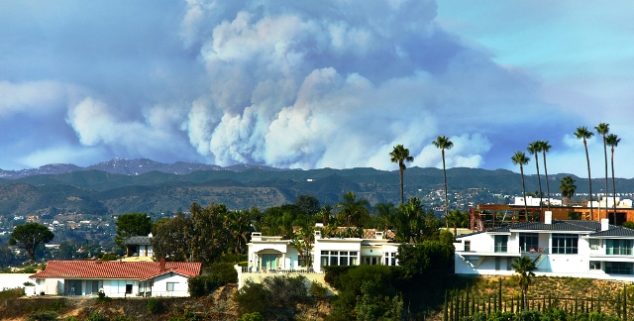Opinion
Smart land use planning, not courts, key to wildfire safety
 The 2018 Woolsey Fire, which ultimately burned nearly 95,000 acres, seen from the Hollywood Hills. (Photo: Jeff Pinette, via Shutterstock)
The 2018 Woolsey Fire, which ultimately burned nearly 95,000 acres, seen from the Hollywood Hills. (Photo: Jeff Pinette, via Shutterstock)California’s startling reminder that its wildfire season is indeed year-round came at the end of January.
The Colorado Fire tore through Monterey County, coming uncomfortably close to the iconic Bixby Bridge. Just weeks after parts of the state saw record snowfall, fire personnel rushed to contain the nearly 700-acre blaze.
Since then, multiple fires have ignited throughout the state, including a 4,000-acre blaze in the Owens Valley. As this winter dry spell continues, we are reminded that the wildfire season has become a wildfire constant.
Responsible land-use decisions should be made at the local level by officials elected to prioritize public safety.
But many Californians don’t need another reminder.
Those who lost homes or had to evacuate the Lake Tahoe region remember very clearly that the August blaze didn’t reach full containment until snowy and stormy weather arrived in October. The Caldor Fire is now one of the largest and most destructive fires in the state’s history.
Record-setting wildfires, fueled by the climate crisis and uncontrolled sprawl, are burning at all times of the year. Yet local officials continue to greenlight hillside projects as if these land-use decisions aren’t linked to the never-ending fire season.
Far too many officials are saying yes to development on land that has repeatedly burned. Thankfully more and more courts are saying no.
Early this year a judge ordered Lake County to set aside its approval of a luxury development that would bring more than 4,000 residents to an area that burned as recently as the LNU Lightning Complex fires in 2020.
In Los Angeles County, a judge cited wildfire risks and halted a housing development that would bring 57,000 residents to the edge of the county. Another sprawl project in San Diego County reached a similar fate due to wildfire and other environmental concerns.
Now’s the time for state lawmakers to ban development in wildlands that are prone to burn.
These are prudent court decisions that factor in the real risks of bringing new residents to fire-prone areas. But these decisions shouldn’t have to be made in a courtroom. Responsible land-use decisions should be made at the local level by officials elected to prioritize public safety.
It takes time and resources to challenge flawed decisions in court. We should instead put our efforts behind reducing fire risks and directing state funding to retrofit existing homes. State and local officials should also take a serious look at prohibiting development in California’s most flammable hillsides.
Northern California leaders recently adopted Plan Bay Area 2050, a long-range vision for the region’s nine counties. The plan includes development restrictions in high and very high fire hazard zones, requirements for defensible space and initiatives to encourage rooftop solar and clean energy microgrids. It’s a decent first step, but these sensible measures won’t make a difference if they are not enforced and risky projects continue to be approved throughout the state.
Nearly all contemporary wildfires in California are ignited by human sources. Continuing the state’s practice of building in fire-prone areas increases the chance that more fires will ignite and more Californians will be put in danger.
Now’s the time for state lawmakers to ban development in wildlands that are prone to burn. If we continue this unsustainable path, scientists estimate that by 2050, up to 1.2 million new homes will be constructed in the state’s highest wildfire-risk areas.
Let’s focus on building homes near city, job and transportation centers. Solving our housing crisis by building up, not out is the best way to address this looming emergency.
As a scientist who is deeply concerned about policies that increase wildfire risks, I urge decision-makers across the state to take the long view.
The perceived economic gains from building luxury housing aren’t worth it if precious resources are spent to protect communities from fire when these homes shouldn’t have been placed in fire-prone wildlands in the first place. And let’s not overlook the $148.5 billion in capital losses, medical costs related to air pollution exposure, and indirect losses due to supply chain issues caused by the 2018 wildfires.
Every year more wildfires force evacuations and wake us up to a new reality. Let’s show that we’ve learned the devastating lessons from past disasters and take bold action. We don’t need any more wake-up calls.
—
Editor’s Note: Tiffany Yap, DEnv/PhD, is a senior scientist at the Center for Biological Diversity.
Want to see more stories like this? Sign up for The Roundup, the free daily newsletter about California politics from the editors of Capitol Weekly. Stay up to date on the news you need to know.
Sign up below, then look for a confirmation email in your inbox.

Leave a Reply